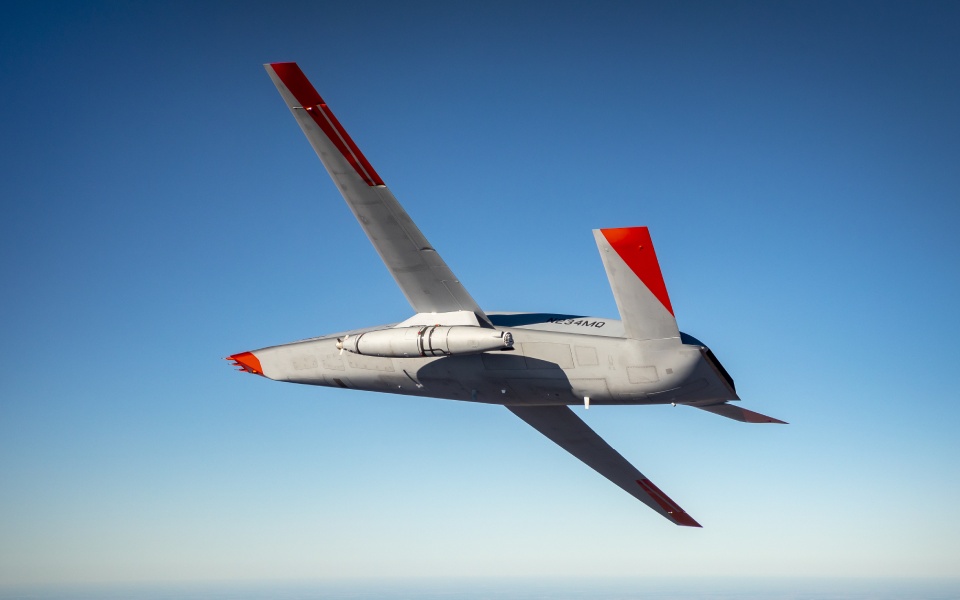U.S. Navy Installs World’s 1st Unmanned Air Warfare Center On USS George H.W. Bush; Sets Stage For MQ-25 Stingray

The USS George H.W. Bush, a US supercarrier, has made history as the first aircraft carrier globally to establish a dedicated Unmanned Air Warfare Center (UAWC), setting the stage for the deployment of the advanced MQ-25 Stingray drone.
The Naval Air Systems Command (NAVAIR) said in a press release published on August 15 that the US Navy recently installed the first Unmanned Air Warfare Center (UAWC) in the world aboard the USS George H.W. Bush (CVN 77), a Nimitz-class aircraft.
The center would be used by Air Vehicle Pilots (AVPs) for controlling future MQ-25 Stingray airborne operations.
The press statement emphasized that the installation took several years to complete, spanning the ship’s deployment timeline and various ship availability windows. The Command, however, did not mention the exact date of installation.
AfriPrime App link: FREE to download...
https://www.amazon.com/Africircle-AfriPrime/dp/B0D2M3F2JT
NAVAIR said, “The CVN-based control room, known as the UAWC, includes software and hardware systems that make up the first fully operational and integrated Unmanned Carrier Aviation Mission Control System (UMCS) MD-5E Ground Control Station (GCS).”
It noted that the UMCS is the system of systems necessary for the command and control of the MQ-25 aerial vehicle and is essential for the functioning of the unmanned aerial refueled.
Unmanned Carrier Aviation (PMA-268) Program Manager Capt. Daniel Fucito was quoted by the press release as saying, “CVN 77’s UAWC lays the foundation for how the U.S. Navy will operate and control unmanned aircraft, and perhaps other unmanned vehicles, with UMCS.”
Providing more specific information, he added, “These systems will initially support the MQ-25 but also future unmanned systems such as Collaborative Combat Aircraft that comprise the Air Wing of the Future.”
A photo was also released by NAVAR that depicts two operator stations with a plethora of monitors, tablet-like gadgets, and other computer technology. The MQ-25 Stingray drones, the Navy’s future unmanned aerial refueling vehicle, will be operated by this control hub. However, analysts contend that it also portends a time when unmanned systems will be more essential for military operations.
The Multi-Domain Combat System (MDCX), which powers the GCS, was developed by Lockheed Martin’s Skunk Works. With comparable systems soon to be planned for other vessels, the successful installation aboard CVN 77 serves as a model for future carriers. The system will eventually be installed on other Nimitz-class carriers as well as the new Ford-class aircraft carriers.
The USS George H.W. Bush will test the UAWC’s networks at sea early next year to confirm the system’s functionality. Unmanned Carrier-Launched Multi-Role Squadron (VUQ) 10 Air Vehicle Pilots (AVPs) will assume command and use the GCS to manage simulated air vehicles during a training exercise.
“The upcoming tests will be a historic moment for naval aviation,” said Joe Nedeau, PMA-268 UMCS lead. “For the first time, AVPs will control unmanned aircraft from an aircraft carrier, marking a significant leap in our operational capabilities.”
AfriPrime App link: FREE to download...
https://www.amazon.com/Africircle-AfriPrime/dp/B0D2M3F2JT
On its part, being the first carrier-based unmanned refueling aircraft in existence, Boeing’s MQ-25 Stingray has successfully performed multiple refueling missions with the US Navy. Three major aircraft, including a F/A-18 Super Hornet, an E-2D Advanced Hawkeye, and a F-35C Lightning II, have been refueled by the MQ-25 T1 test asset.
The setting up of the UAV center further suggests that the MQ-25 Stingray may finally be deployed aboard the carrier soon.
MQ-25 Stingray Is Coming Soon
The MQ-25 is the US Navy’s first unmanned carrier-based aircraft. According to the US Navy, the MQ-25’s main goals are to enable the carrier air wing to expand its reach and to do away with the necessity for F/A-18E/F Super Hornet fighters to perform tanker missions.
Additionally, the Stingrays are expected to be equipped with a secondary intelligence, surveillance, and reconnaissance (ISR) capacity. There have been discussions also regarding the possibility of utilizing the Stingrays as stand-off strike platforms.
The Navy began developing the MQ-25 Stingray project in 2006 to find a carrier-based unmanned aerial vehicle (UAV) that could conduct stealth missions and target precise targets.
On September 19, 2019, Boeing’s MQ-25 Stingray made history in naval aviation when it completed its first flight. The MQ-25 T1 test asset showcased its abilities in real-world scenarios by being successfully deployed in 2021 on the USS George H.W. Bush, a Nimitz-class supercarrier.
Later, on June 4, 2021, the MQ-25 Stingray successfully executed its inaugural aerial refueling mission, supplying 325 pounds of fuel to a F/A-18F Super Hornet. Earlier this year, the US Navy took delivery of the first MQ-25 Stingray autonomous refueler from Boeing, further solidifying the drone’s path toward operational readiness.
The MQ-25 Stingray is designed to blend in perfectly with carrier operations, mimicking crewed fighters such as the Lockheed Martin F-35C and Boeing F/A-18 in terms of recovery and launch procedures.
By utilizing sophisticated flight control algorithms and planning software, the MQ-25 marks the beginning of a new era in unmanned aircraft operations at sea by completing missions and returning to the carrier on its own.

The manufacturer of MQ-25, Boeing, is already looking at adding more capability to the UAV besides refueling. In April this year, it unveiled a revolutionary design for the MQ-25, featuring a version equipped with two Lockheed Martin Long Range Anti-Surface Missiles.
Though this is merely a proposal for now, it marks a significant departure from the drone’s original design as an aerial refueler, hinting at its potential to undertake diverse missions ranging from surveillance to targeted strikes against enemy assets.
The US Navy has outlined plans to procure 76 MQ-25s, including test ones, with a budget allocation of $553 million for three aircraft in fiscal 2025. Further, the Navy had stated that it aspires to achieve initial operational capability for the MQ-25 fleet by the latter part of 2026, with delivery of 13 aircraft.
This indicates that the UAWC has been set up just in time, clearing the path for Stingray’s deployment.
AfriPrime App link: FREE to download...
- Questions and Answers
- Opinion
- Motivational and Inspiring Story
- Technology
- Live and Let live
- Focus
- Geopolitics
- Military-Arms/Equipment
- Güvenlik
- Economy
- Beasts of Nations
- Machine Tools-The “Mother Industry”
- Art
- Causes
- Crafts
- Dance
- Drinks
- Film/Movie
- Fitness
- Food
- Oyunlar
- Gardening
- Health
- Home
- Literature
- Music
- Networking
- Other
- Party
- Religion
- Shopping
- Sports
- Theater
- Health and Wellness
- News
- Culture

